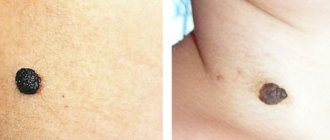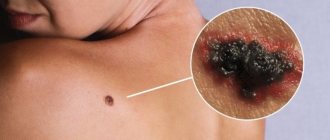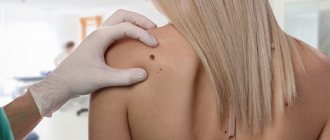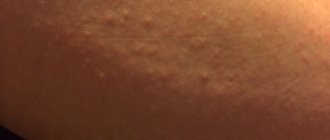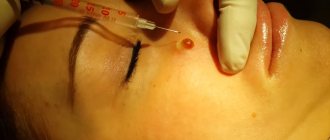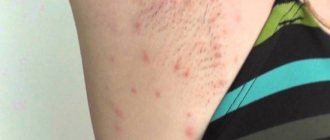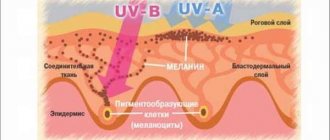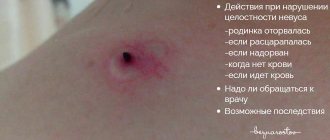A mole is a benign formation located on human skin. Their number can reach several dozen, scattered throughout the body. They can appear due to prolonged exposure to ultraviolet radiation, be inherited by a child, and also with frequent use of hormonal medications. A birthmark may not bother a person all his life, but may constantly swell if it is located in a place that is regularly exposed to mechanical stress.
Causes of moles
At the moment, scientists have not come to a consensus on why moles appear. But still, factors have been identified that most often provoke their formation:
- Hereditary factor - since this information is passed on through DNA, children are likely to inherit moles in the same places as their parents. Inflammation of precisely such nevi should be most alarming;
- Hormonal factor - usually during puberty or pregnancy, the pituitary gland activates the production of melanin, which produces pigment that accumulates in cells - melantocytes - the main “building material” of moles;
- The solar factor is ultraviolet radiation, which provokes the active production of melatonin. Therefore, all sunbathing lovers should not be surprised by the appearance of new moles.
There is another type of moles - vascular. They are formed due to a sharp increase in small blood vessels in the skin. To a greater extent they are characteristic of the female sex. Most often they appear on the face, neck and chest, back and limbs.
Important! Any damage or inflammation of such nevi, especially new ones, is a very alarming signal. Therefore, it is recommended not to delay your visit to a medical facility.
There are many reasons why a mole can become inflamed, but the main ones can be identified:
- Mechanical damage due to impacts, cuts, scratches, rubbing or burns can cause various infections to enter the nevus. Moles on moving parts of the body, for example, under the armpit, are especially susceptible to this. Signs of inflammation may include redness, itching, peeling, swelling of the mole or the appearance of white spots around it, and there may even be pain. And this is a reason to immediately visit a doctor;
- Prolonged exposure to ultraviolet radiation also poses a risk. People with pale, freckled skin and blond or red hair—the so-called first phototype—are especially at risk;
- Degeneration of the nevus, which can be completely asymptomatic or accompanied by redness and bleeding. You need to be very careful in this case - since there is a high possibility of malignant neoplasm.
Attention! The risk group includes people with large pigment spots or many nevi, as well as women during pregnancy.
Places where nevi constantly become inflamed
Moles do not pose a health risk. However, if the location is unfavorable, irritation occurs. Dangerous locations:
- Birthmark on the face. Such a nevus is under constant exposure to ultraviolet rays. In addition, it is easier to damage than a nevus on the body. This can be done with your hand when scratching, with glasses, when shaving, or when using low-quality cosmetics.
- Localization of the birthmark on the nipples. Particular attention should be paid to such moles for women who are breastfeeding. When sucking, the baby can tear off the formation, which will cause inflammation. Men with a nipple spot are not recommended to stay in direct sunlight without clothing for a long time or need to use a protective cream.
- Brown spots on palms and soles. Unlike other areas of the body, they are exposed to regular exposure. The cause of nevus injury on the leg is tight shoes. It is recommended to monitor such formations to prevent inflammation and degeneration into skin cancer.
- Hanging moles. Any localization can cause symptoms of inflammation.
In order to recognize the degeneration of a spot in time, you should remember the symptoms of inflammation. With pathological changes, the spot changes size. There is a sharp increase. The clear contours of the growth disappear. The color of the nevus changes. It turns dark red or black if melanoma develops. When pressed, pain and tightness are felt. The surface of the formation peels and itches.
Doctors' opinions on the most effective methods of treating warts and papillomas
The chief physician of Moscow City Hospital No. 62 describes his vision on this matter. Anatoly Nakhimovich Makhson Medical practice: more than 40 years.
“I have been treating people’s papillomas and warts for many years. I’m telling you as a doctor, papillomas along with HPV and warts can really lead to serious consequences if they are not dealt with.
The human papillomavirus is present in everyone on whose body there are papillomas, moles, warts and other pigmented formations. According to rough estimates, 80-85% of the planet's population has it. By themselves they are not dangerous. The problem is that an ordinary papilloma can become melanoma at any time.
These are incurable malignant tumors that kill a person in just a few months and from which there is no salvation.
Unfortunately, in Russia and the CIS countries, pharmaceutical corporations sell expensive medications that only relieve symptoms, thereby hooking people on one drug or another. That is why in these countries there is such a high percentage of cancer diseases and so many people suffer from “non-working” drugs.
The only drug that I want to recommend, and it is also officially recommended by WHO for the treatment of papillomas and warts, is Papinol. This drug is the only remedy that has an effect not only on external factors (that is, it removes papillomas), but also acts on the virus itself. At the moment, the manufacturer has managed not only to create a highly effective product, but also to make it accessible to everyone. In addition, within the framework of the federal program, every resident of the Russian Federation and the CIS can receive it for 149 rubles.”
To find out more, read this article.
How to take action
When inflammation is detected, a person does not always know what to do. There are a number of actions that need to be taken in this case.
What to do:
- You cannot relieve inflammation on your own using medications or folk remedies. This is especially true for diseases in children. (when a child may develop moles)
- You need to go to a medical institution to see a dermatologist or oncologist. The specialist will conduct an examination and prescribe tests.
If there is no pathology, the medical professional will prescribe appropriate treatment and necessary medications.
What to do if a mole becomes inflamed
It should be understood that diagnosing yourself and treating inflamed moles at home is unacceptable. Consultation with a doctor is required for any changes in a mole.
But in life there are such situations that it is not possible to visit a medical facility immediately upon discovering a problem - while on vacation, on a trip, or simply simply have no time. Doctors recommend taking the following measures to reduce discomfort and possible adverse effects:
- There are several options for how to smear an inflamed mole - alcohol or calendula tincture, any ointments and products containing antibiotics, salicylic acid or zinc;
- You can sprinkle streptocidal powder on the inflamed area;
- Compresses made from celandine tincture for 10 minutes three times a day or from a solution of 1 part dimexide and chlorhexedine and 2 parts saline solution (30 minutes three times a day) also help.
It is advisable to carry out all these procedures no more than five days. If after this period the condition of the nevus has not improved, you need to urgently run to the doctor, since in such a situation the risk of developing melanoma is very high.
Important! Even if the symptoms have subsided, you should visit a specialist doctor as soon as possible. After all, only he will be able to conduct a full examination and find out the real cause of the inflammation.
Diagnostics
If any changes begin to occur with the mole, then you should go to the doctor as soon as possible, since they can be associated not only with infectious inflammation, but also with a life-threatening malignant transformation of the neoplasm.
Currently, the following diagnostic measures are carried out to identify possible malignancy:
| Diagnostic method | Description |
| Cytology | The glass slide is pressed firmly against the surface of the birthmark. The resulting print is then examined under a microscope. The detection of atypical cells is evidence of a malignant process. |
| Dermatoscopy | A modern method that allows you to diagnose melanoma at the earliest stage of development. The formation is examined using a fluorescent microscope with tenfold magnification. |
| Computer Framing | For this diagnostic method, it is necessary to take several high-quality photographs of the skin tumor with a high-resolution digital camera. The resulting photos are loaded into a computer and processed using a special program. |
| Histology | It is used only for complete removal of an inflamed mole using surgical excision or electrocoagulation. Allows you to make an accurate diagnosis in 100% of cases. |
be careful
The presence of papillomas, warts, condylomas, moles and spines on the body is the first sign of malignant melanoma!
We hasten to warn you that most medications “treat” warts, papillomas, moles, etc. - this is a complete deception of marketers who make hundreds of percentage points on drugs whose effectiveness is zero. They do not cure the disease, but only mask the symptoms.
The pharmacy mafia makes huge money by deceiving sick people.
But what to do? How to treat if there is deception everywhere? Doctor of Medical Sciences Anatoly Makhson conducted his own investigation and found a way out of this situation. In this article, the Doctor also told how to 100% protect yourself from melanoma, for only 149 rubles! Read the article in the official source via the link.
Forecast
If the mole was removed by laser, healing will occur within 7-10 days. There are no marks or scars left on the skin after this procedure.
The healing of a tumor excised surgically depends on the results of the analysis. If cancer cells are detected in a mole, the patient must undergo a course of radiation and chemotherapy. If no signs of malignancy were found, then you need to wait until the wound has completely healed.
Life expectancy for melanoma depends on the stage at which it was detected. If the disease was detected at stages 0, 1, 2, the survival rate is 80-97%.
Stages of melanoma
Which doctor should you go to if a mole becomes inflamed?
At the first suspicion, you should contact doctors with specialization in dermatology and oncology. The doctor must examine not only the problem area, but also all other birthmarks, to find out the cause of damage or changes in the nevus.
At the slightest suspicion of cancer, it is recommended to perform a biopsy procedure to exclude the malignant nature of the changes.
If the presence of melanoma is not confirmed, the doctor will perform a siascopic test to determine the complexity of the inflammation. After this, the mole can simply be cauterized or removed surgically, for example, with a laser.
The healing process is quick and painless. If a biopsy was not performed before the removal procedure, then it must be performed on the removed mole.
Associated symptoms of melanoma
Malignancy sometimes occurs without visible symptoms, but in most cases pathological changes can still be seen with the naked eye. Experts from the World Health Organization have created a system for independently determining signs of malignancy. To check your nevus on the face, back or other parts of the body, you need to analyze the following characteristics:
- Asymmetry. Ideally, if you draw an imaginary line through the tumor, it will divide it into two identical halves. If they are different, and one part “slips” to the side, this may be a cause for concern.
- Outlines. Any nevus should have smooth, clearly defined edges, but in a degenerating growth they will be uneven, jagged, and poorly visible.
- Hue. A benign mole does not change its color throughout a person’s life. Melanoma, on the other hand, can quickly darken, affecting not only the tumor, but also adjacent healthy skin.
- Size. Safe moles are no more than 1 cm in diameter, and all growths exceeding this value are subject to constant monitoring.
- Drastic changes. Any changes occurring with the nevus should alert you. This may be the appearance of a white halo, black or red dots, blood or other discharge, cracks, seals and other manifestations. Moreover, all changes occur quickly and irreversibly.
If the mole is inflamed and reddened
Almost always, inflammation of a mole is not malignant; it is often a purely dermatological problem.
Since the mole itself on the skin is located above the level of the hair follicles and sebaceous glands, inflammation can begin in them, and the excretory duct simply passes through the mole. Outwardly it looks like a pimple.
There are many reasons – from microtraumas and pollution to failures in the body’s metabolic processes.
Malignant degeneration of the skin, the so-called melanoma, is dangerous as it develops very quickly. But with early detection of the first signs of the disease, it is successfully treated. Therefore, when the first alarm bells appear (redness, itching, white eagle, change in shape, etc.), you should immediately go to the doctor.
For more information about irritations in the mole area, watch our video:
Possible complications
A birthmark is a collection of melanocytes that synthesize melania located in the layers of the epidermis. The causes of complications, when the mole becomes inflamed and red, can be any dermatological disease.
Contraindications when undergoing the inflammatory process of a mole:
- It is not recommended to wear fairly tight, tight clothing, so as not to rub the irritated mole, which will begin to redden and hurt even more.
- You should avoid exposing the affected area to direct sunlight, especially in the summer. Ultraviolet radiation also leads to complications of the disease.
- It is advisable to avoid taking hormonal medications, avoid stressful situations and overstrain the body.
- When taking a bath or shower, do not use hard washcloths.
It is also recommended to maintain adequate sleep, timely and proper nutrition. It is advisable to take an additional course of vitamins.
Each person should independently examine their own body for large and hanging moles, and constantly monitor changes in their condition. This will help prevent the emergence and development of cancer.
